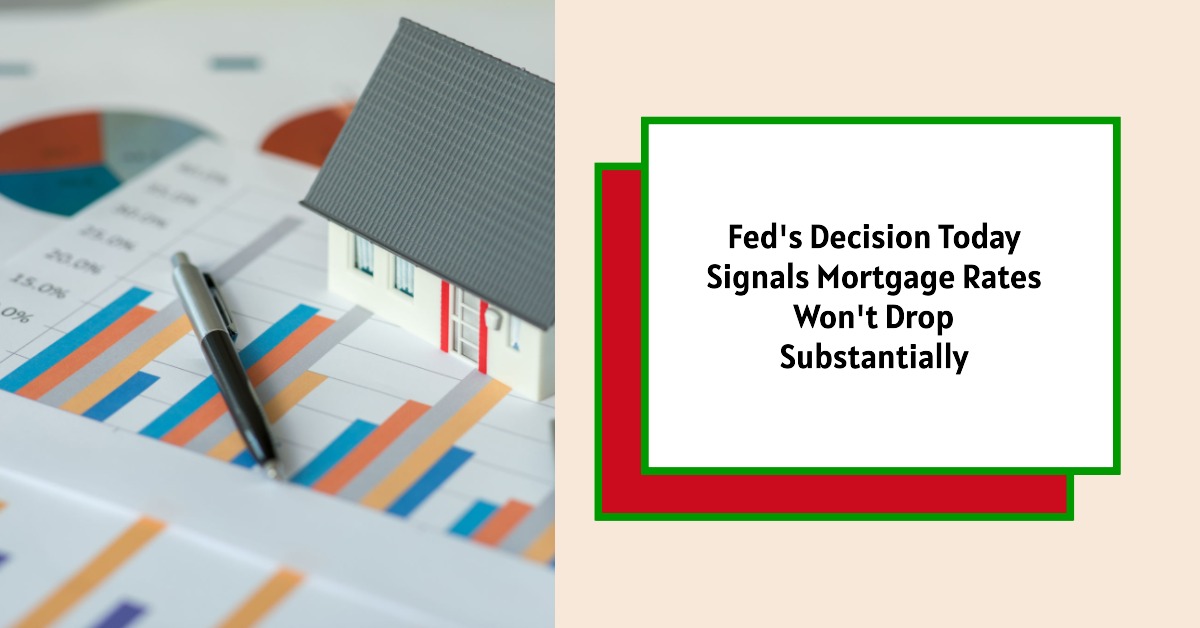And after today's Federal Reserve meeting, it seems that relief for aspiring and current homeowners looking for lower rates isn't coming anytime soon. In a nutshell, the Fed decided to keep interest rates unchanged, signaling that the dream of significantly lower mortgage rates in the near future might have to wait.
Now, I know what you might be thinking: “Why does what a bunch of folks in suits decide affect my monthly housing payment?” It's a fair question, and the answer lies in the intricate dance between the central bank's policies and the broader economy. Let's dive deeper into what this decision means and why I believe today's Fed meeting strongly suggests mortgage rates are unlikely to decrease substantially in the short term.
Fed's Decision Today Signals Mortgage Rates Won't Drop Substantially
Fed's Decision and Its Ripple Effects
The Federal Reserve, our nation's central banking system, wields significant influence over interest rates across the economy. One of its primary tools is the federal funds rate – the target rate that banks charge each other for the overnight lending of reserves. While the Fed doesn't directly set mortgage rates, this federal funds rate acts as a benchmark, influencing the cost of borrowing for banks, which in turn affects the interest rates they offer to consumers for things like mortgages.
At today's meeting, the Fed announced it would maintain this key lending rate. This decision wasn't entirely unexpected, especially considering the mixed signals the economy has been sending. On one hand, we're seeing a relatively strong job market with low unemployment. On the other hand, there are growing concerns about the impact of global trade tensions, particularly the tariffs imposed by the previous administration.
Fed Chairman Jerome Powell himself acknowledged this uncertainty, stating that the economic fallout from these tariffs makes it “not at all clear” what the appropriate path for interest rates should be. This cautious stance highlights a key reason why I don't foresee mortgage rates plummeting soon: the Fed is in a “wait-and-see” mode.
The Tariff Tango: Uncertainty Clouds the Economic Outlook
The data provided clearly points to the disruptive influence of tariffs. The Fed explicitly mentioned that these trade barriers have created “so much uncertainty” that it's difficult to determine the best course of action regarding interest rates. This uncertainty stems from the potential for tariffs to:
- Slow down economic growth: Increased import costs can lead to higher prices for businesses and consumers, potentially dampening demand and investment. Logistics firms and ports have already reported a “sharp drop in trade,” which is a tangible sign of this impact.
- Increase inflation: Tariffs act like a tax on imported goods, which can lead to higher prices for those goods and potentially fuel broader inflation.
Typically, the Fed would cut rates to stimulate a struggling economy or raise them to combat rising inflation. However, the dual risks posed by the tariffs – potential slowdown and rising prices – create a complex dilemma. As Powell aptly put it, “It's really not at all clear what it is we should do… There's so much uncertainty.”
Given this environment, I believe the Fed is unlikely to aggressively cut interest rates, including the federal funds rate that indirectly influences mortgage rates. A rate cut aimed at boosting the economy could exacerbate inflationary pressures caused by the tariffs. Conversely, raising rates to curb potential inflation could further stifle economic growth. This delicate balancing act suggests a period of relative stability in the federal funds rate, which translates to mortgage rates likely staying at their current levels or experiencing only minor fluctuations.
Trump's Pressure and the Fed's Independence
It's impossible to ignore the external pressures on the Federal Reserve. The previous administration consistently called for lower interest rates, even criticizing Fed officials publicly. While the Fed is designed to operate independently of political influence, such persistent pressure can create an interesting dynamic.
However, the Fed's decision to hold rates steady despite this pressure underscores its commitment to its dual mandate of maintaining price stability and maximum employment. I believe the current leadership understands the long-term risks of succumbing to short-term political demands, especially when the economic outlook is so uncertain. This commitment to independence, in my opinion, further reinforces the likelihood of a cautious approach to rate adjustments, meaning significant drops in mortgage rates driven by Fed action are improbable in the immediate future.
Global Economic Headwinds and Mortgage Rates
The US economy doesn't exist in a vacuum. What happens globally can significantly impact our interest rates, including mortgage rates. The data mentions that the European Central Bank (ECB) cut interest rates due to concerns about trade tensions and the Bank of England was expected to follow suit.
While these global actions might seem like they should push US rates down, the reality is more nuanced. If global economic weakness intensifies due to trade disputes, it could create a flight to safety, with investors seeking the relative stability of US Treasury bonds. Increased demand for these bonds can push their yields down, which can indirectly put downward pressure on mortgage rates.
However, this is a scenario driven by economic distress, not necessarily a deliberate policy move by the Fed to lower rates. Moreover, the uncertainty surrounding global trade and its potential impact on the US economy will likely keep the Fed in its cautious stance, preventing any aggressive moves to lower rates that could further complicate the situation. Therefore, while global factors play a role, I don't see them as a catalyst for a significant decrease in US mortgage rates right now.
What Does This Mean for Homebuyers and Homeowners?
So, what's the takeaway for those of us navigating the housing market?
- For Aspiring Homebuyers: If you're waiting for mortgage rates to drop significantly before making a move, you might be waiting for a while. The current economic uncertainty and the Fed's cautious approach suggest that rates are likely to remain in the current range for the foreseeable future. While minor dips are always possible, I wouldn't bank on a substantial decrease in the short term. It might be wise to focus on finding a home that fits your budget at the current rates rather than trying to time the market.
- For Current Homeowners: If you're considering refinancing, the current rates might be the best we see for a while. While refinancing depends on your individual financial situation and goals, the likelihood of significantly lower rates in the near future seems slim based on the Fed's current stance.
Read More:
Mortgage Rates Trends as of May 6, 2025
When Will the Soaring Mortgage Rates Finally Go Down in 2025?
Current Mortgage Rate Snapshot
To give you a clearer picture, here's a quick look at the national average mortgage rates as of the latest data from Zillow:
| Loan Type | Rate (%) |
|---|---|
| 30-Year Fixed | 6.79 |
| 20-Year Fixed | 6.46 |
| 15-Year Fixed | 6.03 |
| 5/1 ARM | 6.96 |
| 7/1 ARM | 7.14 |
| 30-Year VA | 6.34 |
| 15-Year VA | 5.71 |
| 5/1 VA | 6.33 |
Keep in mind that these are national averages, and the actual rates you'll be offered will depend on various factors, including your credit score, down payment, and the specific lender.
Refinance Rates Also Holding Steady
For homeowners looking to refinance, the trends mirror those of purchase mortgages:
| Refinance Loan Type | Rate (%) |
|---|---|
| 30-Year Fixed | 6.80 |
| 20-Year Fixed | 6.43 |
| 15-Year Fixed | 6.07 |
| 5/1 ARM | 7.17 |
| 7/1 ARM | 7.05 |
| 30-Year VA | 6.39 |
| 15-Year VA | 5.99 |
| 5/1 VA | 6.49 |
As you can see, refinance rates are generally in line with purchase rates, and the same factors influencing purchase rates – the Fed's stance and economic uncertainty – will also impact refinance opportunities.
Navigating the Mortgage Landscape
Understanding the forces at play in the mortgage market is crucial for making informed decisions. While we all hope for lower rates, today's Fed meeting suggests that a significant drop isn't on the immediate horizon. The uncertainty created by trade tensions has put the central bank in a cautious position, and until that uncertainty clears, I believe mortgage rates will likely remain at their current levels.
My advice? Stay informed, understand your financial situation, and make decisions based on your individual needs rather than trying to predict the unpredictable movements of the market. The right time to buy or refinance is often when it aligns with your personal financial goals, regardless of minor fluctuations in interest rates.
Turnkey Real Estate Investment With Norada
Investing in real estate can help you secure consistent returns with fluctuating mortgage rates.
Despite softer demand, smart investors are locking in properties now while competition is lower and rental returns remain strong.
HOT NEW LISTINGS JUST ADDED!
Speak with an investment counselor (No Obligation):
(800) 611-3060
Also Read:
- Will Mortgage Rates Go Down in 2025: Morgan Stanley's Forecast
- Expect High Mortgage Rates Until 2026: Fannie Mae's 2-Year Forecast
- Mortgage Rate Predictions 2025 from 4 Leading Housing Experts
- Mortgage Rates Forecast for the Next 3 Years: 2025 to 2027
- 30-Year Mortgage Rate Forecast for the Next 5 Years
- 15-Year Mortgage Rate Forecast for the Next 5 Years
- Why Are Mortgage Rates Going Up in 2025: Will Rates Drop?
- Why Are Mortgage Rates So High and Predictions for 2025
- Will Mortgage Rates Ever Be 3% Again in the Future?
- Mortgage Rates Predictions for Next 2 Years
- Mortgage Rate Predictions for Next 5 Years
- Mortgage Rate Predictions: Why 2% and 3% Rates are Out of Reach
- How Lower Mortgage Rates Can Save You Thousands?
- How to Get a Low Mortgage Interest Rate?
- Will Mortgage Rates Ever Be 4% Again?


